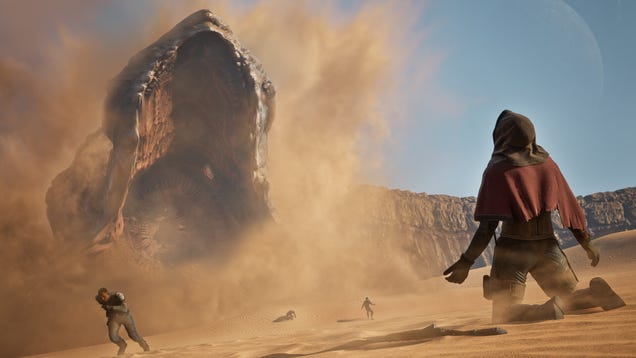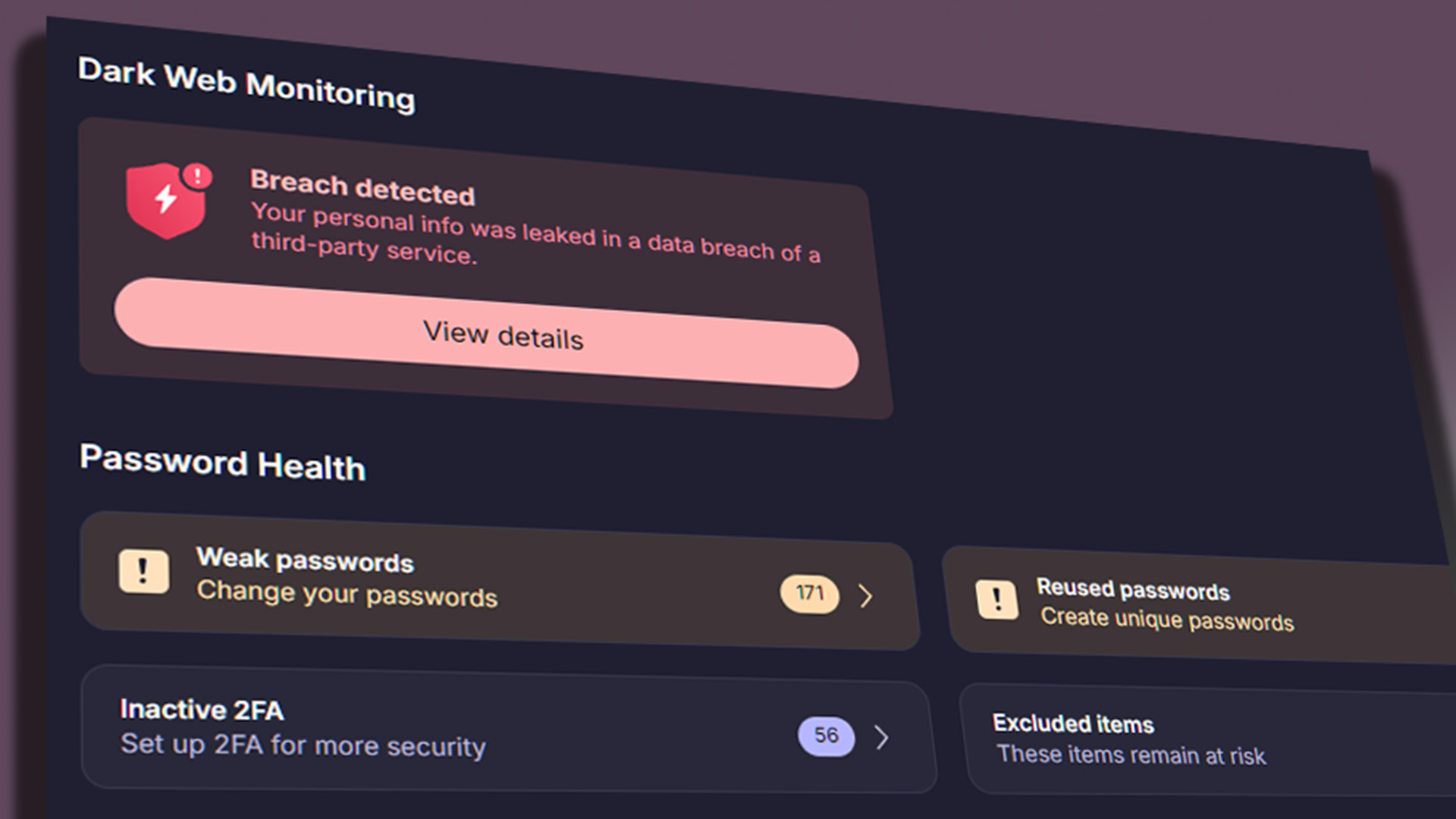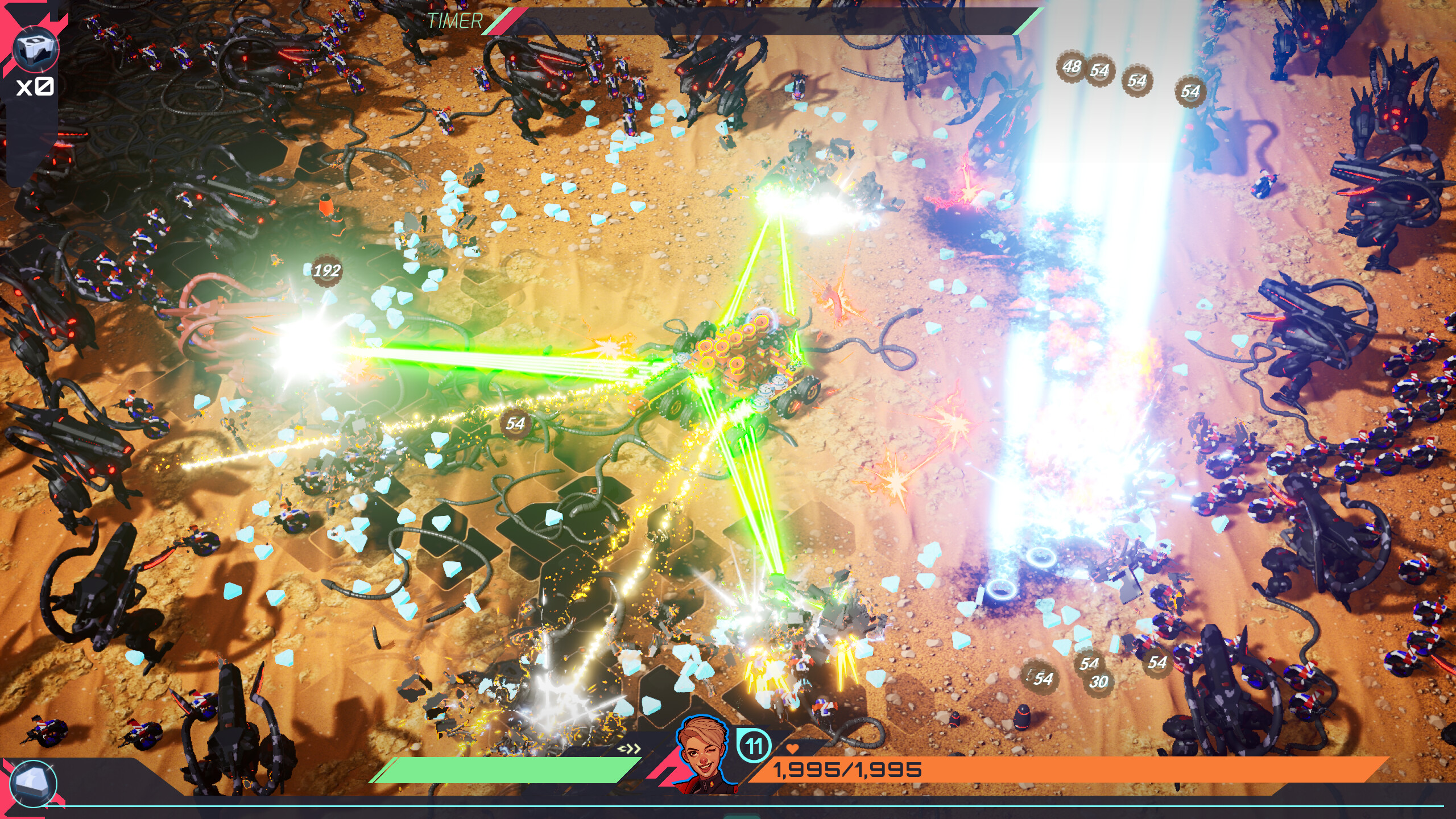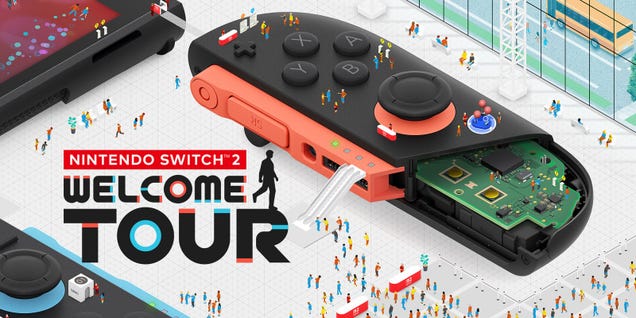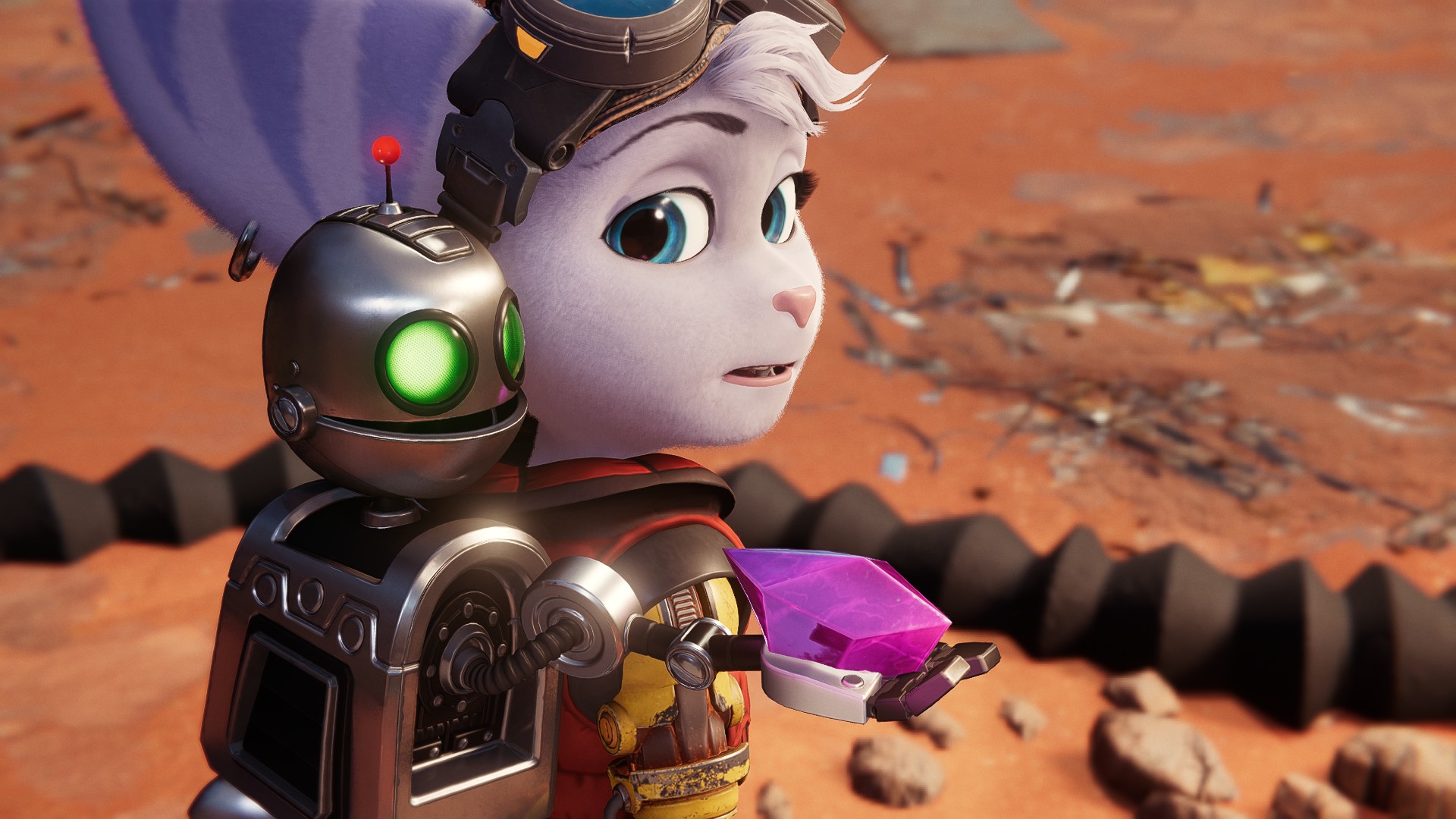
Ported over from PS5, this action-packed adventure is visually spectacular, but struggles to justify its premium price on PC.
What is it? A former PS5 exclusive action-adventure game about multiversal chaos in an alien galaxy.
Release date July 26, 2023
Expect to pay £50 / $60
Developer Insomniac Games, Nixxes Software
Publisher PlayStation PC LLC
Reviewed on AMD Ryzen 9 5900X, 32GB RAM, Nvidia Geforce RTX 3080
Steam Deck Verified
Link Official site
This colourful action-adventure is the quintessential console exclusive. Released for the PlayStation 5 in 2021, it takes a beloved duo of Sony mascots and sends them on a journey designed to show off the specific capabilities of that hardware—particularly its fast-loading SSD, showcased with a story all about hopping seamlessly between different universes. All of which makes it a bit of an oddity to be reviewing on PC in 2023.
Let’s start with the simple stuff. Even if you have no familiarity with the Ratchet & Clank series—which, if you’re a dedicated PC player, you almost certainly don’t—Rift Apart is an accessible introduction. Set in a bright and cartoony sci-fi galaxy, the game follows Ratchet, a furry alien space hero, and his robot sidekick Clank, as they attempt to solve an interdimensional crisis set off by one of their old foes. Though there’s a weight of history here, with tons of references for long-time fans and the pair almost playing the role of retired veterans after their many adventures across the series’ 20 years of games, it’s all easy enough to understand. Clank wants to help Ratchet find his lost people, Ratchet is trepidatious about it, they both want to save the universe—simple.
(Image credit: Insomniac Games, Nixxes Software)
Said interdimensional crisis provides sufficient excuse for yet another multiverse-hopping story—and for the introduction of Rivet and Kit. These two are essentially female versions of the leads, but fully-realised and compelling in their own right, and as totally new heroes provide an even easier lead into the game for newcomers. As you progress through the story, you alternate between playing Ratchet and Rivet, who share all the same abilities and equipment, but have very different outlooks on the world.
The action is pure cinematic adventure. Between regular bouts of third-person shooting and light platforming, you’re thrown into extravagant set-pieces, lavish boss fights, and lovingly-crafted cutscenes, with a little exploration and puzzle-solving for spice. Rarely is it taxing, but it isn’t dull, never letting any of its ideas outwear their welcome over the course of its breezy 10-15 hour runtime.
For a PS5 player in 2021, it was an easy recommendation—with its slick, big budget visuals and buttery smooth performance, it was a solid, if frothy, exclusive, a theme park ride to show off what Sony’s hardware could do. On PC in 2023? Well… my feelings are a little more complicated.
Nuts and bolts
(Image credit: Insomniac Games, Nixxes Software)
The game runs at a smooth 60+ FPS at max settings, wavering to around 45 only in a few particularly dense areas.
Let’s address the elephant in the room: Sony’s interest in PC seems to have been growing in recent years, with a string of high profile ports of its back catalogue, but it hasn’t all been smooth going. Most recently, The Last of Us’ PC port was so poor we had to give one of the most acclaimed console games of all time a 50% review score. The good news is, Rift Apart is not a repeat of that disaster.
With my RTX 3080 graphics card and AMD Ryzen 9 5900X processor, the game mostly runs at a smooth 60+ FPS at max settings, wavering down to around 45 only in a few particularly dense areas. Sequences in which you hop rapidly between dimensions—originally intended to show off how much faster the PS5’s SSD is than the PS4’s hard drive—have had a few noticeable loading pauses for me, but nothing long enough to diminish the spectacle. Indeed, the game has very little noticeable loading time throughout, despite the speed with which you can travel between different levels and planets. Particularly impressive is that even when I switched my installation over from my SSD to a hard drive, I noticed very little difference in loading and performance.
There’s a full range of graphics and display settings to tweak to your liking, including an FOV slider, adjustable weather effects, and you can even choose how the game performs its upscaling. A wealth of control options let you adjust the feel of the game’s action, and there are specific settings for speed-runners that allow you to remove certain pauses and slow-mo elements to shave precious seconds off your time. It’s a robust and fully-featured port, the kind you’d hope to see from one of the biggest game publishers in the world.
(Image credit: Insomniac Games, Nixxes Software)
And though it doesn’t run quite as smoothly as it did on PS5, Rift Apart remains a lovely way to push your hardware. Visual spectacle is the game’s greatest strength, combining technical wizardry with a gorgeously exuberant art-style to create scenes and vistas that are no less impressive for being two years old. Particle effects abound, backgrounds are always dense with activity, dimensional portals send you hurtling from a cyberpunk city to a storm-lashed pirate ship in seconds, and cutscenes feel the equal of many blockbuster animated movies.
It excels at both the big and small details. Enormous robots and towering dinosaurs crash into scenes as a matter of course, but at the same time a wonderful amount of care is given to the subtle movements and facial expressions of its characters. Though the story hardly plumbs complex emotional depths, you’ll certainly find yourself empathising with the central cast a lot more than you ever expected to with a furry-faced alien or a robot the size of a lunchbox.
Gun show
(Image credit: Insomniac Games, Nexxes Software)
The sheer creativity and visual flair of each weapon ensures combat never grows stale.
Every combat encounter is glorious visual chaos. The basic shooting is very straightforward—there’s no cover, and the aiming is very generous, so you’re free to just run around blasting without much need for tactical thinking. What adds colour is a huge arsenal of wild and wacky weapons. Even your most basic options include a shotgun as big as Ratchet that fires double-blasts of coruscating electricity, and a grenade that explodes into pink crystal shards that… also explode. Things only get more wonderfully surreal from there, including a gun that fires rocket drills that burrow under enemies, a sprinkler that turns enemies into topiary, and a summonable mushroom man who aids you in battle.
Though none elevate the strategy much beyond pointing at enemies and clicking, the sheer creativity and visual flair of each weapon ensures combat never grows stale—particularly because you can always bring all of them into battle, your weapon wheel simply gaining more and more tabs to flick between as you fill them up. Each gun also levels up as you use it, unlocking new nodes on an upgrade tree that can be filled out with the game’s primary collectible, Raritanium. Though many of these feel a bit restrained considering the goofiness of the guns—it’s disappointing, for example, that the first major milestone for a weapon that literally blasts enemies into pixelated versions of themselves is just that they’re a bit more likely to drop health when they die—enough investment in your favourite guns does make a noticeable impact in combat.
(Image credit: Insomniac Games, Nexxes Software)
You’re almost as well-equipped for the game’s platforming and exploration. Starting off with a double-jump, grappling hook, and magnet boots, in short order you gain a generous air dash, wall-running, rocket boots that let you blast around at top speed, and more. They’re all put to good use in various escapes and chase scenes over the course of the story, inevitably with things exploding and dimensions tearing open all around you as you go. But they come into their own when you take a break from your quest to go hunting for side content.
Each of the game’s planets is its own little hub. Some are modest—barely more than whatever area you went through as part of the story—while others are like mini open worlds, that you’re free to explore (or, in one case, fly around on the back of an alien dragon). Several have major sidequests to go back and complete, realised with just as much cinematic craft as the main story. And all of them are stuffed with collectibles to uncover, from Raritanium to new outfits to “golden bolts” that let you do everything from reskinning your melee weapon to changing what currency looks like to applying different camera filters.
From another dimension
(Image credit: Insomniac Games, Nixxes Software)
Rift Apart is a console showcase that feels far less vital on PC.
Working your way through everything Rift Apart has to offer is a gentle but satisfying experience. No enemy is that hard to beat, no collectible is that convoluted to find, and there’s plenty of mechanical and visual variety to prevent you getting bored. As a weekend of cinematic adventure and pleasant ticking off of tasks, it’s really endearing.
The problem is that even collecting absolutely everything, doing every sidequest, and fully upgrading every gun in addition to completing the main story only took me about 15 hours total. If you just mainline the critical path, it’ll be 10 hours or less. There is a new game+ mode, with further levels of weapon upgrades to gain, but while I enjoyed my time with Rift Apart, there certainly isn’t enough depth to compel me to immediately replay it.
Brevity is no bad thing in games, but it’s hard to escape the sense that Rift Apart is a console showcase that feels far less vital on PC. Though it came out six months after the PS5, it has all the hallmarks of a launch game—designed to reveal what the hardware can do at a point when not many other options are available. It’s great-looking and likeable—you’d have to be pretty curmudgeonly not to get some joy out of its colourful galaxy—but it’s far more style than substance. At £50 / $60 it’s hard to escape the fact that on PC there are bigger, meatier experiences you could put that money towards.
